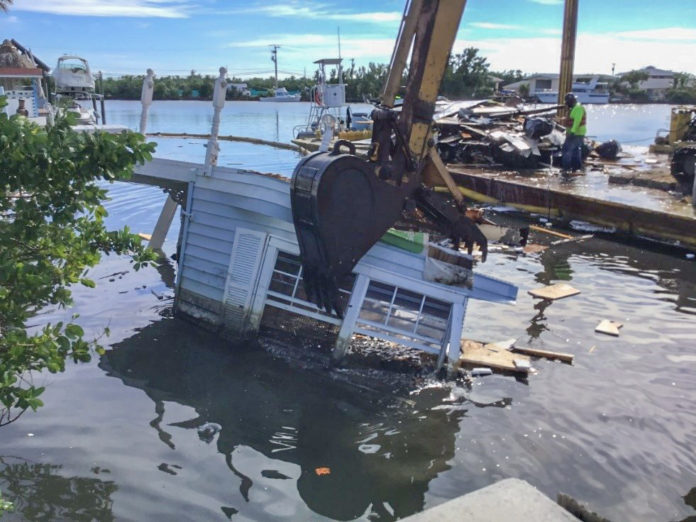
A government project that’s under budget and scheduled to be completed a month or more ahead of time? Yes.
Monroe County’s project to clean up canals clogged with Hurricane Irma debris is projected to come in under budget by as much as $11 million. That includes “extra” canals that were added to the original project’s scope without increasing the cost. And, now it includes some dredging projects as well, or what the county calls “sediment removal.”
As of late January, 79 percent of the 172 canals have been cleared and only 31 percent of the budget has been spent — $14.2 million of $45.8 million. And there’s time to spare, too, with 60 days left to complete the project.
Initially, the county requested approval of the cleanup of 102 canals in Islamorada, Marathon, and unincorporated parts of the county such as Big Pine Key. Then it asked the U.S. Department of Agriculture’s Natural Resources Conservation Services to approve an additional 69 canals. Done. Then, it submitted another 16 for review, but only one — located behind the courthouse in Marathon — received an OK.
“We have 172 canals approved for service and have only 32 canals remaining,” said Monroe County Sustainability Director Rhonda Haag. “There have been no safety or environmental concerns. We see the light at the end of the tunnel.”
At a recent meeting of the Monroe County Board of Commissioners, she told the commission that not one dollar of county money has been invested. The bulk of the money is coming from the federal government, with the 25 percent matching funds paid out of Stewardship Act funds.
When it became apparent that there would be surplus funds, the county began submitting requests for sediment removal under the same grant. While Islamorada had some debris in the canals, the worst problems in the village boundaries were associated with sand-choked canals making navigation possible only for shallow draft boats.
Haag said the county submitted a list of 34 canals to be dredged to the USDA. That has already been knocked down to 18 canals, still under review. The sediment-clogged canals have been identified in Big Pine Key (10), Marathon (3), and Islamorada (5). If those projects are approved, there would still be a surplus of $11.8 million. Haag credited the hard work of the contractors.
Tavernier-based Adventure Environmental (see opposite page) was hired by the county to lead the cleanup. Working with Arnolds Towing of Stock Island, the workforce numbers about 60 people using four grapple trucks, five sonar boats and 15 barges. Wood Environment is monitoring the work.
If there’s a wrinkle, it’s the going rate of what it costs to get things done in the Keys. The federal grant only covers a 7.5 percent fee for auditing work, though the county agreed to a 10 percent fee. The discrepancy means Wood Environmental is waiting on a partial payment of $173,000 of work it has performed.
“The going rate for monitoring costs is about 7.5 percent, but marine debris monitoring costs are usually 10 percent,” said Haag, adding that the state is aware of the conflict and has agreed to pay the differential.
According to the county, canal debris cleanup continues in unincorporated Monroe County and one canal in Marathon. The work in Islamorada is complete.
For more information about cleanup, or to see a schedule, visit monroecounty-fl.gov/irmacanalcleanup.
There are an estimated 500 canals in the Florida Keys. About 34 percent of them were severely impacted by Hurricane Irma.
























